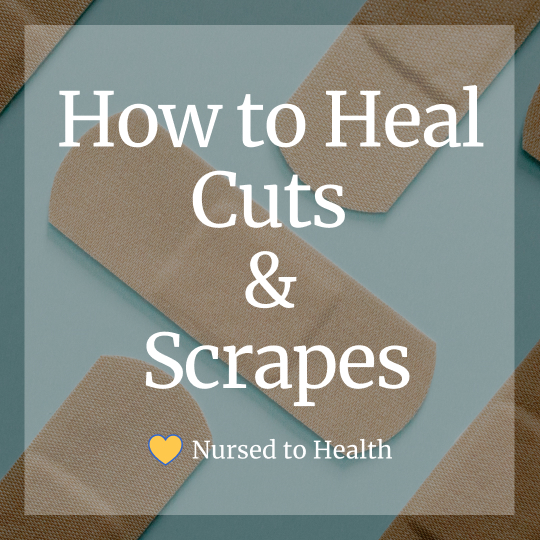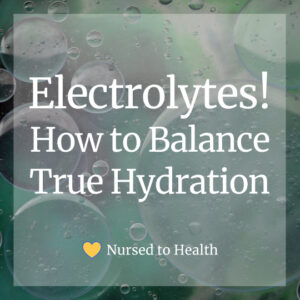How to Heal Cuts, Scrapes, & Wounds
Got a cut or scrape? These minor skin injuries including burns, sunburns, or severely dry/cracked skin can be painful and also a hassle as you wait for it to heal. Generally speaking, a wound needs to be clean but wet to heal completely and properly. For new skin cells to grow, they like to have moisture. This also minimizes pain, reduces scarring and infection risk, and speeds up the healing process!
After you get a skin injury, the first thing to do is to rinse the wound to remove dirt, debris, and germs. Soap and water is best if tolerable, and if not, just water or a simple saline solution. This reduces the risk of infection from germs getting into the body and removes any debris that may hinder healing. Next, these are my recommendations for healing skin wounds:
1. Calendula Ointment
This ointment is an amazing wound healer. Calendula has healing properties that reduce inflammation, bacterial growth, and increase new skin cell growth. It reduces irritation and speeds up tissue repair, also keeping moisture in. The magic really happens when you mix Calendula with Vitamin E oil and apply it to your stinging sunburn or painful cut or scrape. Mixing these 2 together creates a soothing pain relief sensation. It only takes a small amount from both.
2. Vitamin E Oil
This oil is a well-known vitamin and antioxidant helpful in healing skin damage, supporting skin cells, and moisturizing the skin. I keep a tiny bottle of this around at all times, pure Vitamin E oil, with no filler oils. A few drops of Vitamin E oil mixed with the Calendula ointment make the ultimate wound healer. This is my go-to booboo healing mixture.
3. The “Flexible Fabric” Bandaids
These are brilliant. I love these bandages because they are flexible, breathable, durable, and soft. They stick well to the skin without causing damage. They also have a natural feel to them that’s not like a piece of plastic or tape. Who wants to wear plastic tape? These bandaids are comfortable. We are more likely to heal and keep the bandage on if it feels nicer on the body.
4. Antibiotic Ointment – Neosporin, Polymyxin, Mupirocin
Our bodies are sterile on the inside, meaning there are no bad germs inside. Any break in the skin is an opportunity for infection because of the opening to outside germs. So at the first sign of injury, I recommend cleaning a wound and then putting on an antibiotic ointment. This will decrease the risk of infection. If you have a particularly nasty wound that got very dirty, I would apply and re-apply antibiotic ointment for a few subsequent bandage changes. If it was a minor, simple and clean cut, I would apply it once or twice, and then I would refer to the Calendula ointment and Vitamin E oil mixture. Note: Mupirocin is an ointment specific to treating staph infection.
5. Clean, Dry, and Intact
Keep your wound covered until it is healed. The bandage is a protective barrier keeping out germs, providing a cushion, and keeping in moisture. Change your bandage every 12-24 hours or if it gets dirty, wet, comes apart, or falls off. If you see debris or dirt on the wound, rinse gently with water or saline, and then reapply ointment to keep it moist with a new bandage. Make sure your bandage is always, as we say in the hospital, “Clean, dry, and intact!”
6. A&D Ointment
The go-to healer of cracked, dry skin, and the healer of baby bums diaper rash. I have even put this on my lips! A&D Ointment is a wonderful healer due to its historical ingredient of cod liver oil and containing the vitamins, well you guessed it, A and D. These 2 vitamins actively nourish the skin for faster healing, and the petrolatum base keeps moisture in. On that note, we see that Aquafor is a similar ointment with petrolatum as its main ingredient. I don’t like Aquafor as much, but it is a simpler product and is helpful for providing that moisture barrier. Regarding wounds, you can use A&D Ointment when the wound is almost completely healed and you are ready to remove the bandage. This will continue to nourish the skin in that area.
7. Bonus: New Skin liquid bandage
This little vial, like a little nail polish, provides a physical barrier, like a clear glue layer, to protect a wound. I only recommend using this after the wound has a scab on it. It can burn if the wound is fresh or new. This stuff will help kill bad germs and also form a clear coating on top of the wound. It is pretty cool. I have used New Skin on cuts that I really wanted to keep clean. For example, working in the hospital is a germy place. If I had a cut on my hand, I would put New Skin on it, and then also cover with a bandage, just to make double sure no yucky germs got in.
Note
Signs of infection in a wound include warmth, redness, increased pain and swelling, odor, and/or pus. See your healthcare provider if you think a wound is infected. If you have a particularly deep wound, also see your healthcare provider to make sure you don’t need stitches, glue, or help closing that wound.
My RN Soap Box
DO NOT put PEROXIDE on your wounds! We never put peroxide on open skin because it destroys good and healthy cells. Peroxide slows down the healing process and irritates the tissue even more. You see the bubbling and think, “ahh, it’s working,” but you’re really just burning up your healthy skin cells. Please just rinse a wound with water, soap if tolerable, or saline. I see so many people and families putting peroxide on their wounds or even soaking skin in peroxide. We do not do that anymore. Let’s spread the news!
Peroxide Article



